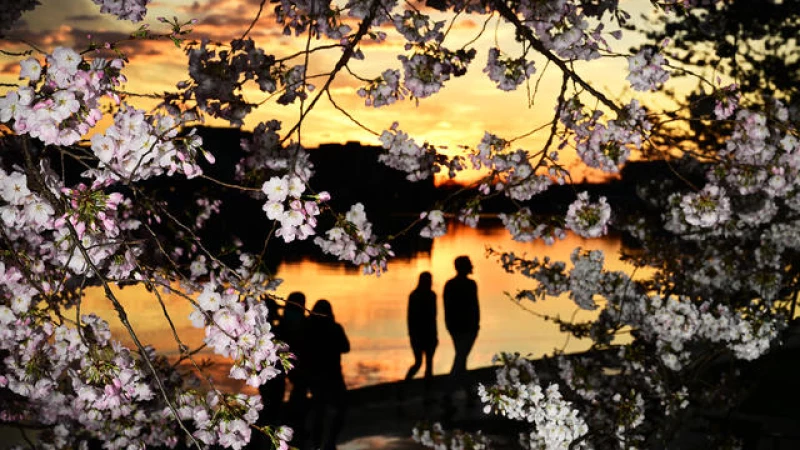The vibrant pink and white blossoms that adorn Washington, D.C. in the early days of spring have reached their earliest peak bloom in over two decades. This year marks one of the earliest occurrences of this natural spectacle in the region's history – a trend that experts believe will continue to shift towards even earlier dates.
Peak bloom signifies the moment when 70% of the enchanting Yoshino cherry blossoms scattered across D.C. have blossomed. Historically, as per the National Park Service, this phenomenon typically unfolds between the final week of March and the initial week of April. Over the past two decades, peak bloom has predominantly fallen within the March 25 to April 10 timeframe, occasionally peaking as early as March 20.
Initial forecasts by the National Park Service had pinpointed this year's peak bloom window between March 23 and March 26. However, in a recent update, the National Mall and Memorial Parks branch of the service shared an exciting announcement on social media.
"PEAK BLOOM! PEAK BLOOM! PEAK BLOOM! Did we mention PEAK BLOOM?!" exclaimed the agency. "The blossoms have begun to unfurl, presenting a magnificent springtime display."
The announcement of peak bloom occurring on March 17 was made by the agency on its website on Monday. The early blooming of cherry blossoms is attributed to various weather conditions, according to scientists and National Park officials.
The agency stated, "Peak bloom varies annually depending on weather conditions," highlighting that the duration of the bloom is also influenced by the weather. Factors such as cool and calm weather can prolong the bloom, while rainy and windy days can abruptly end the blossoms. Additionally, a late frost can prevent the trees from blooming altogether.
Recent projections for D.C.'s peak blossom season align with findings from the Japan Meteorological Agency, which reported that cherry blossoms have been blooming earlier due to increasing global temperatures.
Daisuke Sasano, a climate risk management officer at the JMA's Office of Climate Change, emphasized in a recent briefing that global temperatures have been on the rise. The scientific community has verified that 2023 marked the hottest year on record, with 2024 already experiencing record-breaking heat.
"It is undeniable that human activities have caused the warming of the atmosphere, ocean, and land. Climate change is already impacting all inhabited regions around the world, with human actions playing a significant role in the observed changes in weather patterns and climate extremes," the report stated, referencing the findings of the United Nations' Intergovernmental Panel on Climate Change. "Projections indicate that extreme weather events will become more frequent and intense as global temperatures rise."
Researchers studying a sample cherry blossom tree — known as sakura in Japanese — in Tokyo have discovered that the average blooming date for cherry blossoms in Japan has been advancing, shifting approximately 1.2 days earlier per decade. This trend shows a strong correlation with rising average temperatures, the scientists noted. The trend is not limited to Tokyo alone; other major cities in Japan such as Osaka, Hiroshima, and Sendai have also experienced earlier cherry blossom blooms over the past three decades.
The earliest peak bloom date recorded in Washington D.C. was on March 15, 1990, according to the National Park Service. This year marks the earliest peak bloom in at least twenty years, coinciding with above-average temperatures in the region during January and March. On February 26, Weather Underground reported a maximum temperature of 66 degrees Fahrenheit at Ronald Reagan Washington National Airport – nearly 16 degrees above the historical average.
Global temperatures are projected to continue rising, leading to more frequent and severe weather events that will impact phenomena like cherry blossoms. Even if global greenhouse gas emissions are drastically reduced today, the emissions already present in the atmosphere will continue to influence the climate for decades to come.
Experts from the non-profit organization Climate Central have also highlighted the impact of climate change on cherry blossoms. Historical data shows that between 1931 and 1960, cherry blossoms in D.C. typically bloomed around April 6. However, from 1981 to 2010, the average blooming date shifted to April 1. They further project that in the coming years, blossoms could appear as early as the first week of March.
While last year's cherry blossoms lasted a little over a week, the duration of this year's bloom remains uncertain. The National Weather Service has issued a forecast for a cold front moving into the Northeast U.S. early in the week, bringing potential snowfall and wind gusts of up to 30 mph. Cool and calm weather can prolong the blooming period, but rain and strong winds may hasten the end of the blossoms.







